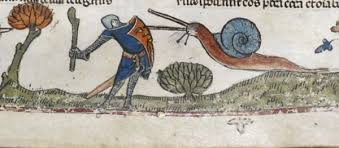No, nothing is original, because if you go back far enough and dig deep enough you can always find one thing becoming another. Ideas have an ecology in the same way that living creatures do, passing their memetics down from one generation to the next, memes prove successful according to the society in which they thrive, and vanishing where they fail. Occasionally something ancient will rear its head and find a niche, like an intellectual coelacanth, or a pattern will prove so utterly successful that it will reappear in varying forms from generation to generation, like the shark or crocodile.
We all know internet memes, surrealist non sequitur humour, comedy born of masses of minds throwing spaghetti at the internet and seeing what sticks. In so many of today’s memes you can still see the patterns left behind by the Advice Dogs, notably the top and bottom framing font in white Impact with a black outline, and that may still be instantly recognisable there are people joining the internet today who wouldn’t recognise an Insanity Wolf if it stuffed them in a blender and drank the n00b smoothie that poured out. The badly spelled “He Protecc”, you can still see the heritage of Rage Comics, and even the Lolcats that preceded them.
There’s a line of surrealism in humour, the kind of comedy that is seemingly born of chaos and irrationality, through The Mighty Boosh, Reeves and Mortimer, Monty Python’s Flying Circus, back to the days of radio comedy, the Spike Milligan, Harry Secombe, and Peter Sellers classic, The Goon Show.

This is comedy of clever stupidity, a fast paced hurricane of bizarre humour, a few well timed misunderstandings and a subversion of expectations, then a curveball thrown into the plot before a punchline that lands like a damp napkin, an anticlimax to completely subvert the very idea of a traditional narrative, but even they had their patterns and running gags.
The doltish Neddy Seagoon would inevitably fall prey to the criminal machinations of Jim Moriarty and Grytpype-Thynne, the lad Bluebottle would get killed in a blundering and obvious fashion, and Eccles would be told to shut up by himself. These things can be predicted, unlike a competition for a land-speed record in a Wurlitzer pipe organ, or the native britons halting war with the Roman invaders for “rough play”.
Give an episode or two a listen, they’re available in vast numbers on YouTube, and you’ll hear the inspiration behind so many comedy greats of today, the reoccurring gags and characters, the erratic tones of speech and rapid fire delivery. You can even hear the mark upon internet meme humour. If you trace it further back we might have a solid explanation for ancient knights doing battle with giant snails.

Nothing is original. A friend of mine engaged me on the topic of infinity a few months ago, and his sister rather tritely observed what a foolish errand it was. I don’t know why he chose the Matrix as his example as something that has a definite beginning and an end, and yet he could barely finish the sentence before I was asking where the Matrix began? Was it on the day of release, the start of filming, in the writing? Or could it be in all of the works that inspired it, the misinterpreted works of Jean Baudrillard, the philosophies and religions, the anime, the sci-fi, all the contributing factors the have their origins extending from the nineties all the way back to year 0HE and the dawn of culture? All of human history building to one film that has in turn gone on to inspire hundreds, maybe even thousands of other works.
Nothing is original, no, not even this article, which started as a half baked idea at 23:00 the night before publishing as I idly re-watched the Punisher and thought “Damn, I need to write something” and instead shovelling Christmas shortbread into my face. It’s not new to say that there are “no new ideas” to be found any more, nor is it new to liken the spread of thoughts and ideas to the spread and mutation of species. Nevertheless, it’s a fascinating thing to look at media as a breeding ground for ideas, and to see their populations rise and fall.
